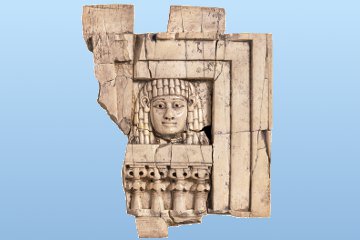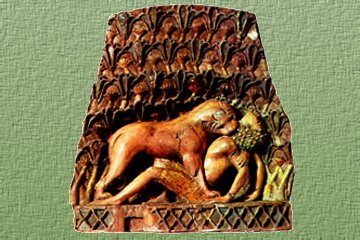Two Tusks

| |
| An ivory plaque depicting a woman in an Egyptian wig looking out of a window. |
According to the Bible, Ahab built for himself a "house of ivory" in Samaria, an off-the-cuff statement which, in my youth, conjured up the picture of a bone-white ramshackle construction made out of elephant tusks. In fact, I gather that a good many Bible students were puzzled, as ivory is not the substance that first leaps to mind when considering building materials.
It wasn't until archaeologists turned their attention to Samaria that the mystery was solved, for amid the burned ruins of the Israelite palace they discovered thousands of pieces of carved ivory - 12,000 pieces in all. And what carvings! Delicate figures of plants, trees, imaginary creatures like the griffin, and so on, all highly polished and frequently coloured or even gilded.
Two figures in particular stick in my mind. One depicts a woman's head wearing a heavy Egyptian-style wig, framed by carved panels. The discoverers called it "the woman looking out of a window" and referred to the story of Jezebel, who met an unfortunate fate after looking out of her window. As similar figures have been found, it is apparent that it was just a motif rather than a reference to any particular individual.

| |
| A small ivory plaque depicting a lioness killing a negro. |
The other plaque showes a lioness standing over a negro who is lying on the ground but propping himself up on his elbows. The lioness has her teeth buried in his throat. The background is of a thicket of unidentifiable flowering plants. Only two of this type have been found: one is in the British Museum, where I have seen it, and the other used to be in the Baghdad Museum but its present whereabouts are unknown.
From the size and style of these pieces of ivory it was obvious that they were inlay decorations for wooden furniture, and the style further showed that they were produced by Phoenician craftsmen who took elements of Egyptian and Hittite art and combined them in a unique way that some have dismissed as "derivative" (the ultimate insult in the art world) and others praised as "creative" (the ultimate compliment in the art world).
Whatever the modern judgement on the ivories, however, one thing is clear: in the ancient world they were the ultimate in luxury. Layard discovered a horde of the ivories at the bottom of a well in Khorsabad (Dar Sharrukin) where they had presumably been thrown at the time the palace was destroyed and there was speculation that these represented the spoils of war brought back from Ahab's palace when the Assyrians conquered Samaria. This idea lost favour when more ivories were found in the palace of Ashurnasirpal II at Nimrud, for he ruled a century before Samaria was destroyed, so must have acquired the ivories from the Phoenicians by way of trade. The extent of this trade is shown by the fact that a few individual ivories have been found in tombs as far away as Etruria and Salamis.
Recently the Louvre in Paris has published its collection of Phoenician ivories and this has allowed scholars to undertake a more detailed study of the subject. Already it is becoming possible to identify, if not particular artists, at least particular schools of artists, and to relate them to their places of origin, such as Arwad or Sidon. Professor Gerogina Herrman of University College, London, now wants to undertake a study - possibly using modern technology such as genetic fingerprinting - to determine places of origin with greater precision than is possible on stylistic grounds.
I can foresee some interesting results, for although it is reasonable to suppose that all the ivories with a particular genetic fingerprint came from one elephant, it must not be forgotten that elephants have two tusks - and it is quite possible for traders to sell those tusks separately. Can you hear the arguments that will rage as the geneticists assert that these two plaques came from the same workshop because they came from the same elephant and the stylists assert that it is as plain as the nose on your face that they came from different workshops because the styles are completely different.
Happy days.





